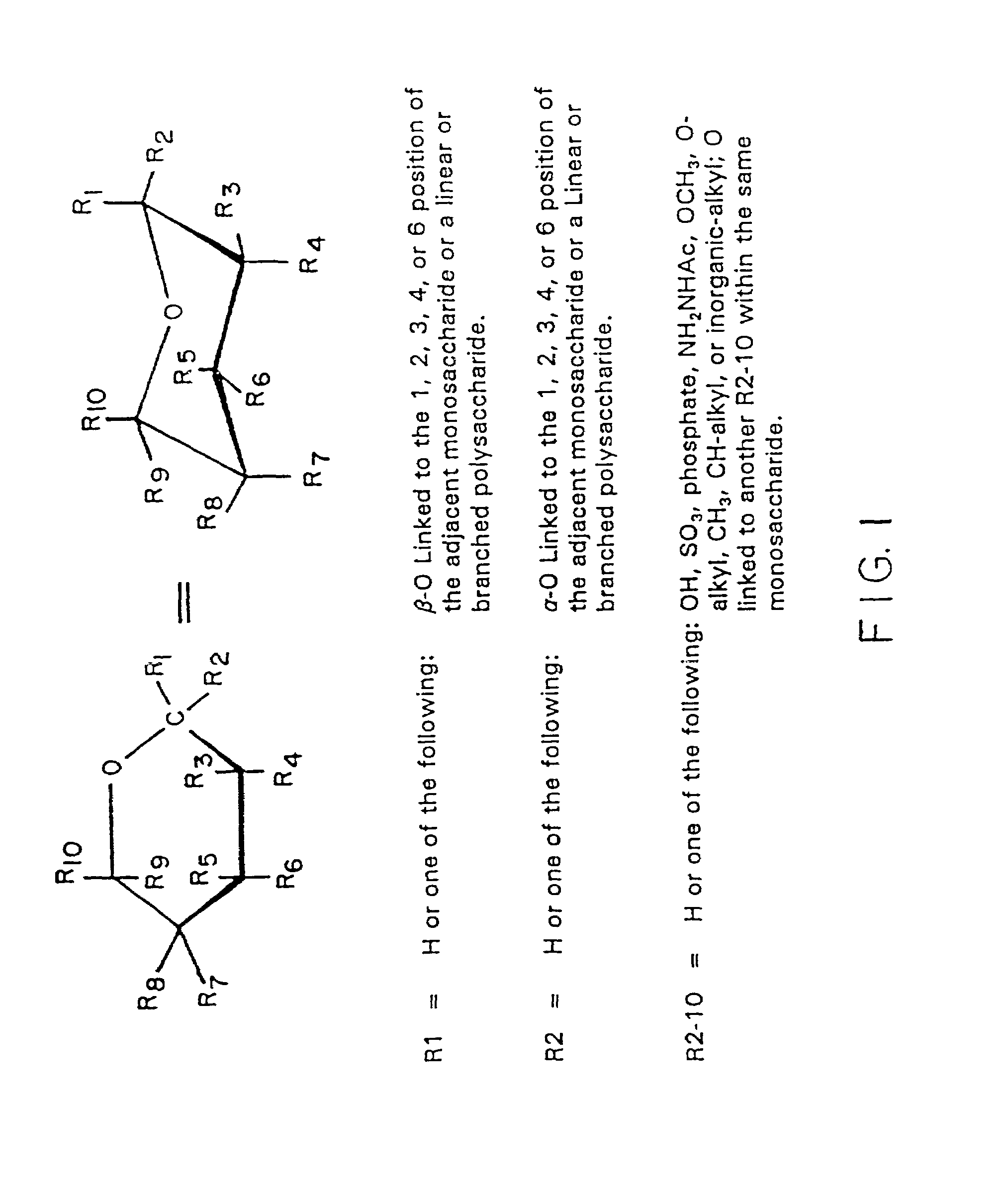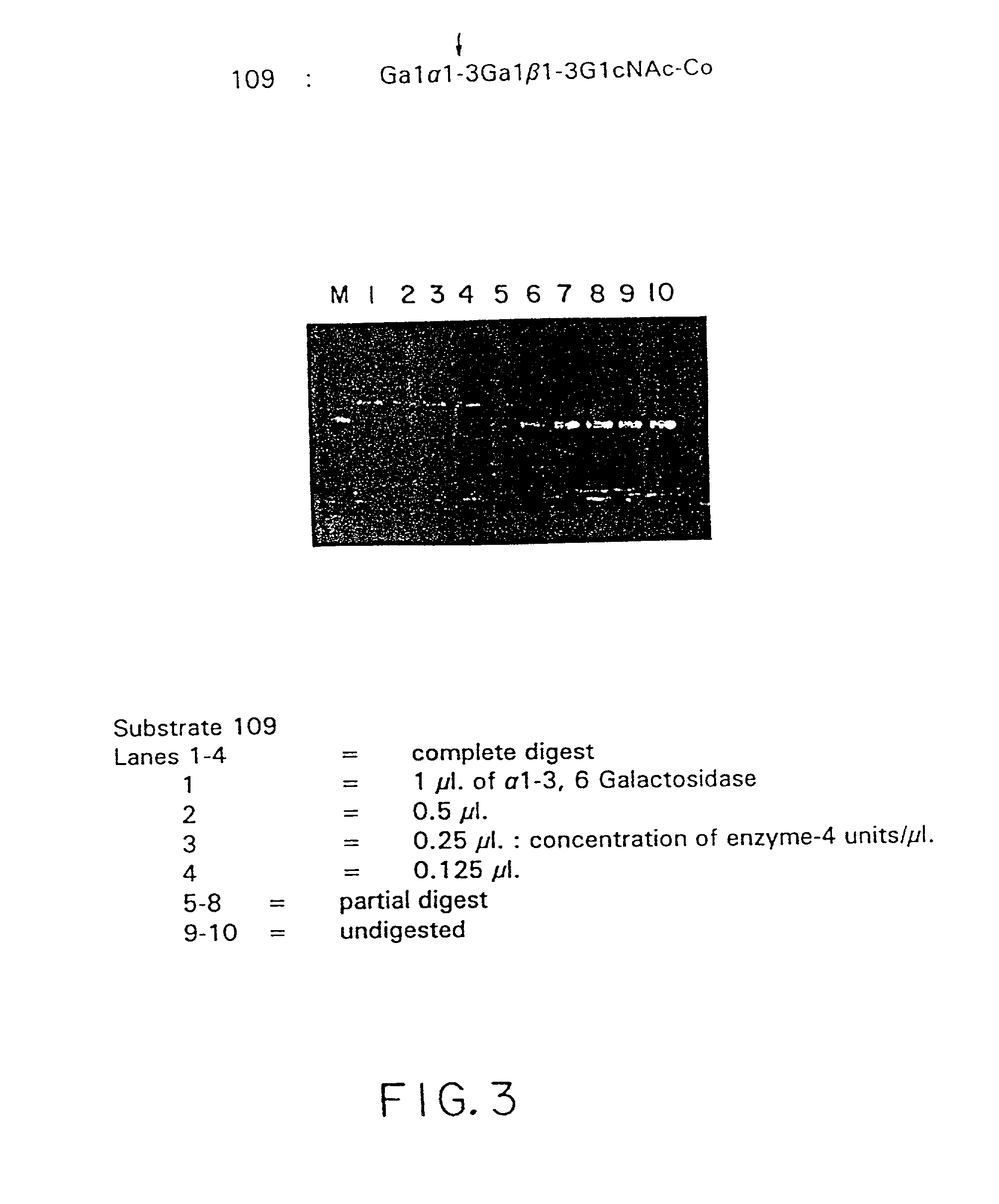Isolation and composition of novel glycosidases
a glycosidases and glycosylation technology, applied in the field of new glycosidases, can solve the problems of microorganism reversibility, inter-cellular variability in glycosylation patterns, and carbohydrate lagged behind other types of carbohydrates
- Summary
- Abstract
- Description
- Claims
- Application Information
AI Technical Summary
Problems solved by technology
Method used
Image
Examples
example 1
Preparation of Substrates for Enzyme Assays: AMC-labeling of Oligosaccharides
[0112]0.25 to 1 mg oligosaccharide (either commercially obtained from Accurate Chemical and Scientific Corp., Westbury, N.Y.; Sigma Chemical, St. Louis, Mo.; Pfanstiehl Labs, Waukegan, IL.; and V-Labs Inc., Covington, La. or isolated according the method incorporated by reference from Carbohydrate Analysis: A Practical Approach (1986) Eds. Chaplin, M. F. Kennedy, J. F. (IRL Press Limited, England) pp. 150–151)
[0113]0.1 to 5.0 μmoles oligosaccharide was dissolved in 100 μl H2O. The aqueous carbohydrate solution was added to a solution containing 300 μl methanol, 20 mg (0.11 μmole) AMC(Eastman Kodak-Rochester N.Y.), 35 mg (0.55 μmole) NaCNBH3 and 41 μl glacial acetic acid. The mixture was sealed into a screw cap microfuge tube and heated in a dry block at 80° C. for 45 minutes. The reaction was loaded onto a G-25 column (2×50 cm) equilibrated with deionized water. The product was eluted with deionized water a...
example 2
Method For Screening Organisms For Glycosidase Activity
Preparation of Cell Extracts For Screening Assay.
[0114]0.1–0.5 g of cell paste was thawed and suspended in three volumes of Buffer A″ (20 mM Tris-HCl pH 7.5, 50 mM NaCl, 1 mM EDTA). The cell suspension was briefly sonicated before being centrifuged at 14,000 rpm for 10 minutes at 4° C. in an Eppendorf microcentrifuge.
Glycosidase Digestion Reaction.
[0115]1–5 μl of bacterial cell extract or cell growth media or partially purified extracts were added to a 10 μl reaction mixture containing 1 nanomole of AMC labelled substrate in 50 mM Na citrate buffer (various pH's and cofactors; see Table 5). The reaction was incubated at 37° C. for a period in the range of 5 minutes to 20 hours. 2–3 μl of reaction was spotted in a band onto a silica gel TLC plate as described below. One unit of enzyme was defined as the amount of enzyme required to release 1 nmole of terminal monosaccharide from an oligosaccharide substrate at 37° C. in 1 hour.
An...
example 3
Method For Purification of Glycosidases From Xanthomonas manihotis
Fermentation of Xanthomonas manihotis.
[0122]Xanthomonas manihotis strain NEB 257 (ATCC #49764) was grown in media consisting of 1 g / l yeast extract, 2 g / l tryptone, 6 g / l sodium phosphate (dibasic), 3 g / l potassium phosphate (monobasic), 0.5 g / l NaCl, 1 g / l ammonium chloride, 2 g / l glucose, 1 mM calcium chloride, 1 mM magnesium sulfate. The cells were incubated at 30° C. until late logarithmic stage with aeration and agitation. The cells were harvested by centrifugation and stored frozen at −70° C.
Preparation of Crude Extract.
[0123]All further procedures were performed either on ice or at 4° C. 254 grams of cell paste obtained above were suspended in two volumes of Buffer A (20 mM Tris-HCl (pH 7.5) 50 mM NaCl, 0.1 mM EDTA). The cell suspension was passed through a Gaulin homogenizer (Model M-15) twice at 12,000 psi. The lysate was centrifuged at 1,300 g for 40 min in a Sharples continuous centrifuge. 500 ml of super...
PUM
| Property | Measurement | Unit |
|---|---|---|
| Fraction | aaaaa | aaaaa |
| Acidity | aaaaa | aaaaa |
| Acceleration | aaaaa | aaaaa |
Abstract
Description
Claims
Application Information
 Login to View More
Login to View More - R&D
- Intellectual Property
- Life Sciences
- Materials
- Tech Scout
- Unparalleled Data Quality
- Higher Quality Content
- 60% Fewer Hallucinations
Browse by: Latest US Patents, China's latest patents, Technical Efficacy Thesaurus, Application Domain, Technology Topic, Popular Technical Reports.
© 2025 PatSnap. All rights reserved.Legal|Privacy policy|Modern Slavery Act Transparency Statement|Sitemap|About US| Contact US: help@patsnap.com



